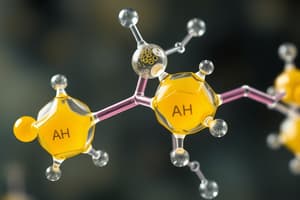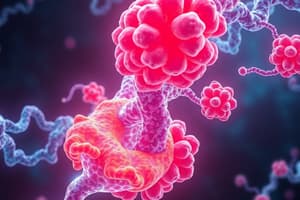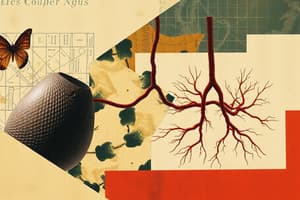Podcast
Questions and Answers
What is the primary function of gluconeogenesis in animals?
What is the primary function of gluconeogenesis in animals?
- To maintain adequate glucose levels in the blood (correct)
- To store excess glucose as glycogen
- To convert fatty acids into glucose
- To break down glucose into energy
Which organs are responsible for gluconeogenesis in animals?
Which organs are responsible for gluconeogenesis in animals?
- Pancreas and lungs
- Brain and muscle
- Heart and spleen
- Liver and kidney (correct)
What is the biggest consumer of glucose in the body?
What is the biggest consumer of glucose in the body?
- Brain (correct)
- Kidney
- Muscle
- Red blood cells
During which periods is gluconeogenesis particularly important?
During which periods is gluconeogenesis particularly important?
Which organ can use ketone bodies as an alternative fuel source?
Which organ can use ketone bodies as an alternative fuel source?
What is the role of oxaloacetate in gluconeogenesis?
What is the role of oxaloacetate in gluconeogenesis?
Which compound is synthesized from fructose-1,6-bisphosphate during gluconeogenesis?
Which compound is synthesized from fructose-1,6-bisphosphate during gluconeogenesis?
What is the final product of gluconeogenesis?
What is the final product of gluconeogenesis?
Why is the reciprocal regulation between glycolysis and gluconeogenesis emphasized?
Why is the reciprocal regulation between glycolysis and gluconeogenesis emphasized?
What is the fate of glycerol released from adipose tissue?
What is the fate of glycerol released from adipose tissue?
Which molecule is glycerol converted to in the liver?
Which molecule is glycerol converted to in the liver?
What is the role of pyruvate kinase in glycolysis?
What is the role of pyruvate kinase in glycolysis?
Why is the conversion of pyruvate to phosphoenolpyruvate considered a strongly exergonic reaction?
Why is the conversion of pyruvate to phosphoenolpyruvate considered a strongly exergonic reaction?
Where does the process of converting pyruvate to phosphoenolpyruvate start?
Where does the process of converting pyruvate to phosphoenolpyruvate start?
Which of the following statements about gluconeogenesis is correct?
Which of the following statements about gluconeogenesis is correct?
What provides the energy necessary for driving the carboxylation of pyruvate to oxaloacetate?
What provides the energy necessary for driving the carboxylation of pyruvate to oxaloacetate?
What is the prosthetic group required by pyruvate carboxylase for carrying CO2 in a reactive manner?
What is the prosthetic group required by pyruvate carboxylase for carrying CO2 in a reactive manner?
Why is acetyl CoA referred to as an obligate allosteric activator of pyruvate carboxylase?
Why is acetyl CoA referred to as an obligate allosteric activator of pyruvate carboxylase?
Why does oxaloacetate need to be converted to malate for transport out of the mitochondria?
Why does oxaloacetate need to be converted to malate for transport out of the mitochondria?
Which enzyme converts oxaloacetate to malate in order to facilitate its transport out of the mitochondria?
Which enzyme converts oxaloacetate to malate in order to facilitate its transport out of the mitochondria?
What happens to malate once it reaches the cytosol?
What happens to malate once it reaches the cytosol?
Why does pyruvate carboxylase require acetyl CoA in addition to biotin?
Why does pyruvate carboxylase require acetyl CoA in addition to biotin?
What happens if there is no bound acetyl CoA to pyruvate carboxylase?
What happens if there is no bound acetyl CoA to pyruvate carboxylase?
Which vitamin is biotin derived from?
Which vitamin is biotin derived from?
Why does oxaloacetate need to be transported out of the mitochondria into the cytosol?
Why does oxaloacetate need to be transported out of the mitochondria into the cytosol?
What was surprising about the two enzymes, PFK-2 and FBPase-2?
What was surprising about the two enzymes, PFK-2 and FBPase-2?
What became evident upon determining the structure of the bifunctional enzyme?
What became evident upon determining the structure of the bifunctional enzyme?
What triggers the phosphorylation of the single serine residue in the regulatory domain of the bifunctional enzyme?
What triggers the phosphorylation of the single serine residue in the regulatory domain of the bifunctional enzyme?
What effect does phosphorylation of the serine residue have on the bifunctional enzyme's activities?
What effect does phosphorylation of the serine residue have on the bifunctional enzyme's activities?
Why is the phosphorylation of the single serine residue important for the regulation of the bifunctional enzyme?
Why is the phosphorylation of the single serine residue important for the regulation of the bifunctional enzyme?
Which hormone is responsible for signaling phosphorylation of the serine residue in response to low blood sugar?
Which hormone is responsible for signaling phosphorylation of the serine residue in response to low blood sugar?
What cell signaling cascade leads to the phosphorylation of the serine residue in the regulatory domain?
What cell signaling cascade leads to the phosphorylation of the serine residue in the regulatory domain?
What is a central role of the pentose phosphate pathway (PPP)?
What is a central role of the pentose phosphate pathway (PPP)?
Which molecule serves as the currency of reducing power for most reductive biosynthetic reactions?
Which molecule serves as the currency of reducing power for most reductive biosynthetic reactions?
What does ribose 5-phosphate, generated by the PPP, provide the sugar component for?
What does ribose 5-phosphate, generated by the PPP, provide the sugar component for?
In what tissues is the pentose phosphate pathway (PPP) particularly active?
In what tissues is the pentose phosphate pathway (PPP) particularly active?
Which key molecule does the PPP share with glycolysis, leading to coordinated regulation?
Which key molecule does the PPP share with glycolysis, leading to coordinated regulation?
What is the primary function of NADPH in the pentose phosphate pathway?
What is the primary function of NADPH in the pentose phosphate pathway?
How does ribose 5-phosphate contribute to the production of DNA and RNA?
How does ribose 5-phosphate contribute to the production of DNA and RNA?
Why is it important that the regulation of the pentose phosphate pathway (PPP) and glycolysis are coordinated?
Why is it important that the regulation of the pentose phosphate pathway (PPP) and glycolysis are coordinated?
Which molecule is considered the currency of reducing power for most reductive biosynthetic reactions?
Which molecule is considered the currency of reducing power for most reductive biosynthetic reactions?
In the Pentose Phosphate Pathway, what is the primary function of the oxidative phase?
In the Pentose Phosphate Pathway, what is the primary function of the oxidative phase?
What is the main outcome of the non-oxidative phase of the Pentose Phosphate Pathway?
What is the main outcome of the non-oxidative phase of the Pentose Phosphate Pathway?
Why is it important for the Pentose Phosphate Pathway to divert excess ribose-5-P to glycolysis?
Why is it important for the Pentose Phosphate Pathway to divert excess ribose-5-P to glycolysis?
Which molecule serves as a significant product of the Pentose Phosphate Pathway?
Which molecule serves as a significant product of the Pentose Phosphate Pathway?
What is the main role of the Pentose Phosphate Pathway in relation to glycolysis?
What is the main role of the Pentose Phosphate Pathway in relation to glycolysis?
Which phase of the Pentose Phosphate Pathway involves the conversion of ribulose-5-P to ribose-5-P?
Which phase of the Pentose Phosphate Pathway involves the conversion of ribulose-5-P to ribose-5-P?
Why does the Pentose Phosphate Pathway need a mechanism to divert excess ribose-5-P to glycolysis?
Why does the Pentose Phosphate Pathway need a mechanism to divert excess ribose-5-P to glycolysis?
Which process is facilitated by the interconversion of 3-, 4-, 5-, 6-, and 7-carbon sugars in the Pentose Phosphate Pathway?
Which process is facilitated by the interconversion of 3-, 4-, 5-, 6-, and 7-carbon sugars in the Pentose Phosphate Pathway?
What is the main purpose of the Pentose Phosphate Pathway (PPP) as discussed in the text?
What is the main purpose of the Pentose Phosphate Pathway (PPP) as discussed in the text?
What is the significance of the PPP in relation to glycolysis?
What is the significance of the PPP in relation to glycolysis?
Which molecule is primarily used as the reducing power currency in most reductive biosynthetic reactions?
Which molecule is primarily used as the reducing power currency in most reductive biosynthetic reactions?
What is the sugar component provided by ribose 5-phosphate synthesized in the PPP for nucleotide production?
What is the sugar component provided by ribose 5-phosphate synthesized in the PPP for nucleotide production?
Why is it crucial for the PPP to generate ribose 5-phosphate?
Why is it crucial for the PPP to generate ribose 5-phosphate?
What is the relationship between the PPP and NADPH production?
What is the relationship between the PPP and NADPH production?
How does the Pentose Phosphate Pathway (PPP) contribute to nucleotide synthesis?
How does the Pentose Phosphate Pathway (PPP) contribute to nucleotide synthesis?
How does the regulation of the Pentose Phosphate Pathway (PPP) relate to glycolysis?
How does the regulation of the Pentose Phosphate Pathway (PPP) relate to glycolysis?
What is the rate-limiting step in the Pentose Phosphate Pathway (PPP)?
What is the rate-limiting step in the Pentose Phosphate Pathway (PPP)?
What is the primary role of NADP+ in the Pentose Phosphate Pathway?
What is the primary role of NADP+ in the Pentose Phosphate Pathway?
Why does a high concentration of NADPH result in a low rate through the PPP?
Why does a high concentration of NADPH result in a low rate through the PPP?
What factor primarily determines which pathway glucose-6-P will be funneled into?
What factor primarily determines which pathway glucose-6-P will be funneled into?
Why is glucose-6-P considered a key molecule in the regulation of the Pentose Phosphate Pathway?
Why is glucose-6-P considered a key molecule in the regulation of the Pentose Phosphate Pathway?
What would be the consequence of a high concentration of NADPH in terms of PPP activity?
What would be the consequence of a high concentration of NADPH in terms of PPP activity?
How does the cytosolic concentration of NADP+ impact the Pentose Phosphate Pathway?
How does the cytosolic concentration of NADP+ impact the Pentose Phosphate Pathway?
What is the primary function of the oxidative phase in the Pentose Phosphate Pathway?
What is the primary function of the oxidative phase in the Pentose Phosphate Pathway?
What is the second major product of the Pentose Phosphate Pathway?
What is the second major product of the Pentose Phosphate Pathway?
Why is it important for the PPP to interconvert sugars of different carbon lengths?
Why is it important for the PPP to interconvert sugars of different carbon lengths?
What is the fate of excess ribose-5-P that needs to be diverted from the PPP?
What is the fate of excess ribose-5-P that needs to be diverted from the PPP?
Which phase of the PPP involves converting ribulose-5-P to ribose-5-P?
Which phase of the PPP involves converting ribulose-5-P to ribose-5-P?
What is the purpose of producing NADPH in the Pentose Phosphate Pathway?
What is the purpose of producing NADPH in the Pentose Phosphate Pathway?
Why does the PPP produce more NADPH than ribose-5-P?
Why does the PPP produce more NADPH than ribose-5-P?
What is the significance of interconverting 3-, 4-, 5-, 6-, and 7-carbon sugars in the PPP?
What is the significance of interconverting 3-, 4-, 5-, 6-, and 7-carbon sugars in the PPP?
In Mode 3, where is the scenario with the need for greater NADPH than ribose-5-P, what is the fate of the ribulose-5-P produced by the oxidative portion of the PPP?
In Mode 3, where is the scenario with the need for greater NADPH than ribose-5-P, what is the fate of the ribulose-5-P produced by the oxidative portion of the PPP?
In Mode 4, which statement best explains how glucose-6-P can produce ATP despite ATP not being directly produced by the PPP?
In Mode 4, which statement best explains how glucose-6-P can produce ATP despite ATP not being directly produced by the PPP?
Which metabolite produced in Mode 4 can directly contribute to ATP production?
Which metabolite produced in Mode 4 can directly contribute to ATP production?
What is the end result of every glucose-6-P being oxidized in Mode 3?
What is the end result of every glucose-6-P being oxidized in Mode 3?
Which phase of the Pentose Phosphate Pathway produces NADPH and includes the conversion of glucose-6-P to ribulose-5-P?
Which phase of the Pentose Phosphate Pathway produces NADPH and includes the conversion of glucose-6-P to ribulose-5-P?
What is the primary purpose of converting ribulose-5-P to ribose-5-P in Mode 3?
What is the primary purpose of converting ribulose-5-P to ribose-5-P in Mode 3?
Which metabolite from the PPP can be utilized for gluconeogenesis to produce glucose-6P in Mode 3?
Which metabolite from the PPP can be utilized for gluconeogenesis to produce glucose-6P in Mode 3?
What is the significance of every glucose-6-P being oxidized to 6CO2 in Mode 3?
What is the significance of every glucose-6-P being oxidized to 6CO2 in Mode 3?
Which metabolite conversion occurs first after glucose-6P is oxidized in Mode 4?
Which metabolite conversion occurs first after glucose-6P is oxidized in Mode 4?
'Both NADPH and ATP are required' refers to Mode 4 in which glucose-$6P$ oxidation requires both molecules. Which pathway is essential for NADPH production in this mode?
'Both NADPH and ATP are required' refers to Mode 4 in which glucose-$6P$ oxidation requires both molecules. Which pathway is essential for NADPH production in this mode?
Flashcards are hidden until you start studying




